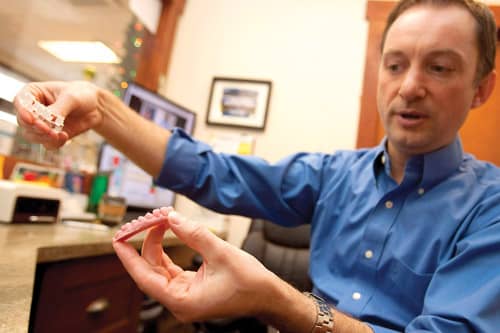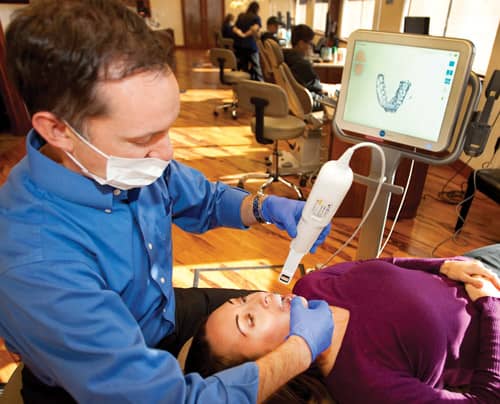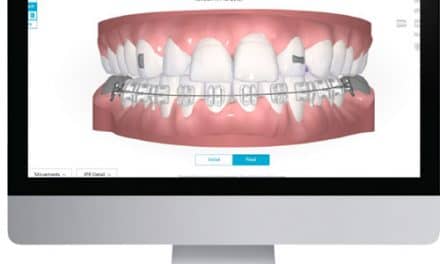Digital technology has gone a long way to shake up orthodontics. Practice management software streamlined the front office. Digital intraoral scanners and treatment planning software featuring 3D technology allowed for better treatment planning and improved patient communication. Now 3D printing offers practices an opportunity to eliminate outsourcing of model and appliance fabrication. The digital evolution is racing ahead, but how does an orthodontist keep up, let alone integrate all the different pieces?
By dipping one toe in the water and wading in.
One orthodontist who has taken the plunge is Fort Collins, Colo-based Brandon Owen, DDS, MS. For the last 5 years, Owen has been all in when it comes to digital orthodontics. His primary goal has been to identify the digital pieces flooding into the orthodontic space and figure out a way to vertically integrate them to create a system that maximizes the technology’s potential to impact the field. The end goal: A turnkey solution that saves orthodontists time—and money—without compromising treatment quality.
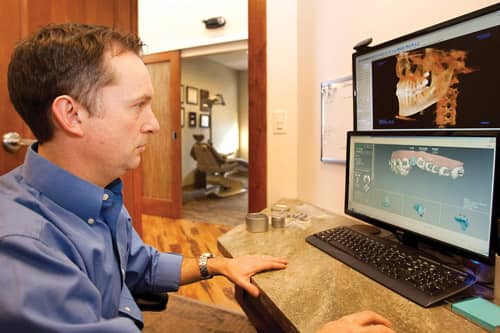
Owen performs a digital setup using the DIBS software (bottom monitor) while evaluating root positions on the Anatomage software (top monitor).
The Opportunity in Digital Indirect Bonding
Owen, who currently has two offices with partner Adam Timock, DDS, MS, argues that many orthodontists have not transitioned to digital, and for those who have, the focus tends to be on how digital technology serves their aligner treatment. What they are missing is the ability to integrate digital technology with traditional brackets and wires—specifically through indirect bonding.
When Owen did his first in-office digital indirect bonding case 3 years ago, the process required 2 hours of his time and over 300 clicks of the mouse. Today, Owen loves that Utah-based OrthoSelect with its digital indirect bonding system known as DIBS has created a system that does most of the work for him. “I scan the case, send it to them, and they return an already decently set up case. I then spend 3 minutes fine-tuning the final positions of the teeth and hit approve. They then actually go in and design the indirect bonding tray for me, so I don’t have to. Then they send it to my [EnvisionTEC] Vida printer, and I hit print. Now I have a digital IDB solution that only requires about 3 minutes of doctor time.”
Last fall, Owen did his first same-day start using DIBS. The patient was scanned in the morning, and the braces placed in the afternoon.
“That’s a huge value position,” says Owen. “Going from a 5- to 7-week turnaround time to the same day—that’s awesome.”
The benefits, though, extend beyond time saved for the orthodontist and the patient. The price point at which this can be done makes the process all the more attractive. The OrthoSelect DIBS fee for creating the indirect bonding tray is between $60 and $80 per arch (depending on who does the printing). Owen then printed the tray in-house with his EnvisionTEC Vida 3D printer. He estimates that cost at $10 in terms of time and material. “So, for $130 I’ve got a digital IDB setup that I’m using to make treatment more efficient,” he says.
Central to this digital workflow is CAD/CAM (ie, computer aided design/computer aided manufacturing) technology. CAD/CAM allows the system user to both design a product and control the manufacturing process. As Owen sees it, the cost in both dollars and time of using this technology in the practice has become a fraction of what it once was. Coupled with the fact that the technology will allow for more optimally planned cases, less treatment time, and fewer office visits, CAD/CAM, and digital technology overall, create an opportunity for increased practice profitability.
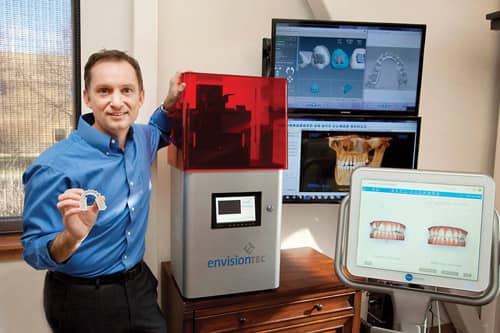
Owen’s digital workflow includes an intraoral scanner, the DIBS and Anatomage software, and a 3D printer.
Where the Money Is
While a 3D digital workflow that includes in-house 3D printing can be used to fabricate in-house retainers and even expanders as described in a recent issue of the American Journal of Orthodontics & Dentofacial Orthopedics, these tasks aren’t necessarily big income generators. “You can 3D print a model, take the braces off digitally, and make an Essix retainer from a 3D printed model. Though exciting, this process is likely to be more expensive than conventional methods, and at best it may generate $50 more than alginate and stone. However, you’re only going to see that benefit the office—$100 or $200 a day total—because that’s how many braces you may be taking off,” Owen points out.
Yes, there’s a cool factor in being able to use 3D printing for these appliances, but the financial return isn’t going to be there with these appliances alone. Instead, Owen argues that the financial benefit of a digital workflow that fully utilizes CAD/CAM technology is in digital indirect bonding. “You’re going to be making thousands more dollars in profit per day in digital indirect bonding because you’re likely going to save seven or eight office visits with that patient, without compromising the result.”
In-house aligners also offer financial rewards to the practice, says Owen. “If a doctor is spending upwards of $1,800 on Invisalign®, bringing aligner staging and fabrication into the office and avoiding such a high lab bill will really impact the bottom line.”
The Next Step in Customization
Moving beyond aligners and indirect bonding, Owen is focused on how CAD/CAM and 3D technology can be used to create a truly custom bracket system where the patient can actually start treatment the same day as the digital scan. Here again, Owen is focused on the idea of developing a system that is going to bring thousands, not just hundreds, of dollars a day into the practice.
As Owen sees it, the current indirect bonding systems use a standard bracket system. They can build a digital setup using a number of different bracket systems and send the practitioner a bonding tray with no problem. However, Owen argues that while the bracket systems currently on the market do a really good job with first and second order movements, there are about 20 to 30 degrees of “slop” in the third order—that needs improvement. “Because you can’t control all three orders of movement with a standard bracket system—even if you switch to a 3Shape, suresmile® elemetrix™, Arcad, Exceed, or OrthoSelect DIBS [indirect bonding system], you’re still going to have to put bends in the wire to overcome that obstacle,” Owen maintains.
While there are companies currently offering custom brackets and wires, Owen aims to create a system that has both a quick turnaround time and a lower price point. As he calls it, he’s trying to create a “Lego kit” where each bracket system is based on the needs of each individual patient.
“Instead of having one bracket that fits each tooth and using the same set of braces on every patient that walks through the front door, with my system, we’ll actually use the software—initially with DIBS—to set the teeth where they belong, like Invisalign. Then the software will go and select the right shaped Lego for your tooth to get into that position.
“So you’ll have all the inventory in your own office already. It will still be between 25 and 30 brackets that will be sitting in a box on your desk, which is what you have now—though the computer will tell you which one to put in the tray for each tooth. So I can put a lower incisor anywhere from -25 degrees to 25 degrees and have the bracket still hug the tooth very intimately. This will allow us to finally use full-sized archwires and truly unlock the potential of CAD/CAM,” says Owen, who will start clinical trials with his custom bracket system this summer.
Such a system also offers a practice the opportunity to differentiate itself from the competition argues Owen, a Montana native who has been practicing in Colorado since completing his residency at the University of Minnesota 12 years ago.
“If we have a patient come to the office, I can tell the parent, ‘Rather than using the same set of braces on everyone who walks through the front door, for your son/daughter, I’m going to choose a custom set of braces just for his/her mouth. It’s going to allow us to treat the case with a significant reduction in treatment time, which means less soreness, less discomfort, and less missed school [for appointments].’”
Meanwhile, for the orthodontist, this means fewer appointments. “An orthodontist could charge the same for the case and may only need to see a patient nine times using CAD/CAM and teledentistry instead of 18 times using conventional methods. Every time that patient sits in the chair, they’ve doubled their cost per visit. The efficiencies and payoffs with digital are huge.”
Digital Payoff
The financial gains are all the more important for practices that accept insurance. “I think insurance is taking a stronger hold of the profession,” says Owen, who is on the board of Delta Dental Colorado. He points out that insurance is expecting orthodontists to reduce their case fees, sometimes by $1,000 plus—a huge hit to a practice’s margins.
“I’ve made a point to tell the board members ‘that by directing customers and employers to sign up for EPO or PPO plans, you are forcing doctors to see as many as four patients for the same profitability as one of the cash paying patients,’ but it’s the reality of where the market is heading,” says Owen.
He argues that a custom bracket system that is designed using CAD/CAM technology can soften the blow. For an extra $100 to $200 on the front end, a practice could save thousands of dollars on the back end and actually make it profitable to treat cases at a $4,000 to $4,500 level. “I see CAD/CAM as a huge tool to allow us to stay very viable and profitable,” says Owen.
While much of the discussion has hinged around financial benefits, the paramount achievement of customization is what the patients receive: better results in less time. The question all orthodontists field more than any other, “‘When do I get my braces off?’ We will soon be able to answer with ‘Sooner than we were ever able before,’” says Owen.
Analog vs Digital
As Owen sees it, aligners have made great strides forward because of digital. Now it’s time to even the playing field for braces, which have been mired in an analog world.
But this isn’t simply about braces vs aligners. This is ultimately about digital vs analog Owen argues.
“If you listen to Joe Hogan, the CEO of Align Technology, he’s saying that it’s not really a battle between plastic and metal in terms of aligners versus braces. He said it’s a battle between digital and analog. In the history of the human race, when a digital product has gone head-to-head with an analog product, digital’s won every single time. So he’s saying this is an analog to digital conversion.
“I totally agree with him. And I think we need to start using CAD/CAM to make our appliances fit each individual, not be a one size fits all,” he says.
Owen compares this evolution to the introduction of the Andrews prescription. As recently as the 1980s, orthodontic practices were using a “no prescription” bracket, meaning every bracket was similar in shape and size. The orthodontist had to put a bend between every single tooth in all three orders of movement to get the teeth in the right position. The process was laborious. Orthodontists saw only 15 to 25 patients per day, but with the introduction of the Andrews prescription, orthodontists easily doubled the number of patients seen per day because they no longer had to put every single bend between every single tooth.
Now, digital technology, ie, CAD/CAM, makes another orthodontic evolution possible. “Yes, we’ve got a one-size-fits-all system that’s definitely eliminated the amount of bends in all three dimensions that we need to make, but why not go to the next level?” Owen asks. “We actually have the technology now where we can design people’s bites and smiles perfectly and then select the best-fit wire for the arch and bracket for each tooth.”
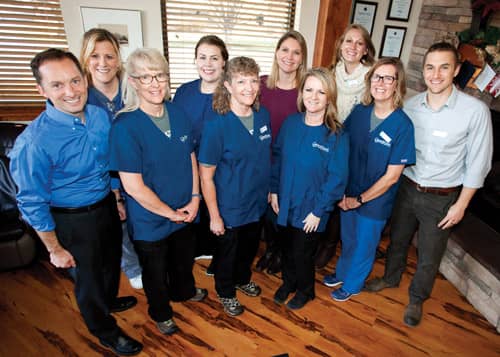
Owen currently has two offices with partner Adam Timock, DDS, MS, (far right) who joined the practice 3 years ago.
Outsource to Start
While much of the talk about digital technology is about how orthodontists can bring everything in-house and no longer rely on outsourcing, that isn’t a requirement of a successful digital workflow. As Owen points out, for his digital indirect bonding cases, he is using OrthoSelect’s technicians/lab to create the patient’s custom tray. “I would say that’s the smarter way to go now,” he says. As the different software systems evolve with more automation, true insourcing will become the norm. “I think you’re going to see in about 3 to 4 years from now everything will be done in office. Nothing will be outsourced.”
But Owen points out this is going to require a new workforce that is trained to do digital indirect bonding and to manipulate tooth movement. “The reality is we have to actually develop a whole new position in the orthodontic office,” he says, adding that he plans to offer digital lab technician training in the next couple of years.
This staff member would be trained on all the different software systems, such as 3Shape, suresmile, or OrthoSelect, and know how to segment the teeth, how to move the teeth, and how to create an initial setup. They would learn the different nuances between the different softwares.
For now, though, using a lab, like OrthoSelect, that has the trained technicians is a way to leverage their experience while your practice transitions into technology like digital indirect bonding.
While you may not be ready to go all in on a digital workflow, Owen recommends you still start. “All the orthodontic CEOs that I have ever met have told me that they think within 7 years all fixed and removable appliances in orthodontics will be digital CAD/CAM. That’s where we’re going. Everybody agrees. So even if you don’t want to go all in, start learning a little bit. Start training your digital brain now. Start getting your feet wet, because if you don’t, I feel you’re going to be left behind.” OP

